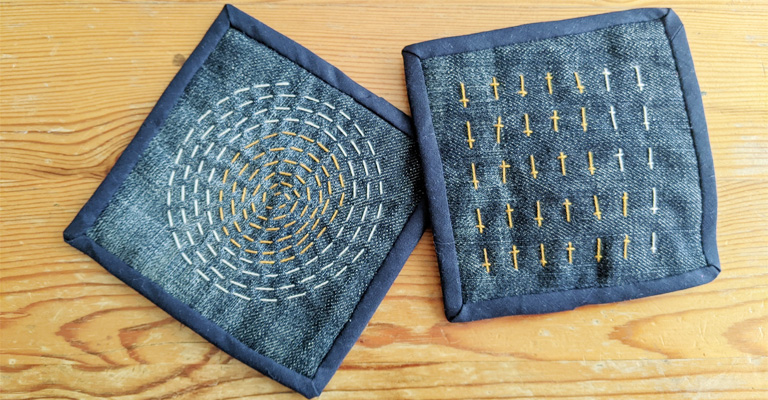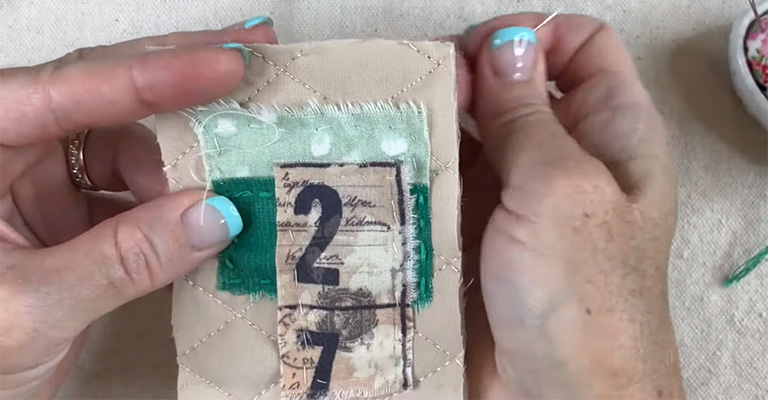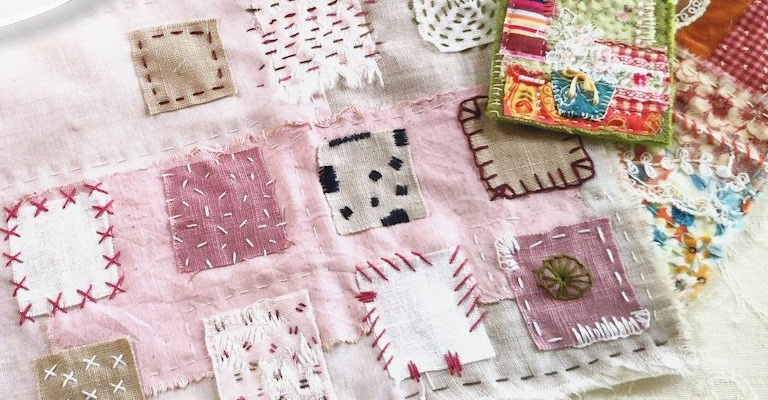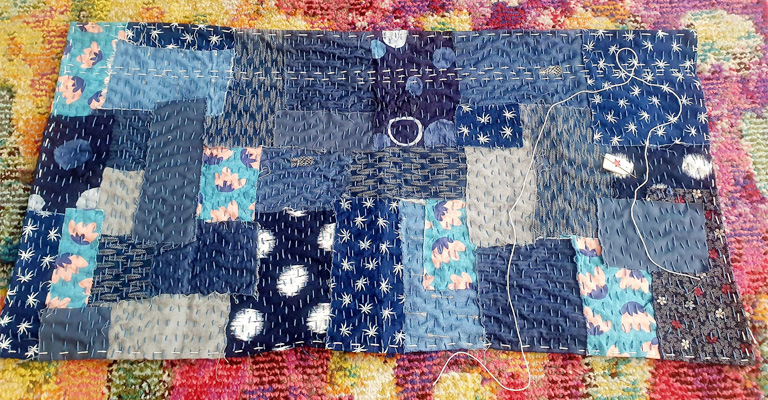In a world characterized by the relentless pace of modern life, there exists a serene and meditative practice known as “slow stitching.” At its heart, slow stitching is an art form that champions a deliberate and unhurried approach to handcrafting.
Rooted in age-old traditions and cultures, it invites practitioners to savor the tactile beauty of textiles and engage in a mindful, creative process.
Slow stitching transcends the boundaries of mere utility; it is an artful celebration of imperfections, a homage to intricate detail, and a testament to the enduring human connection with handwork.
Whether through embroidery, quilting, or simple hand sewing, it fosters a sense of calm and contemplation, providing respite from the frantic rhythms of the modern world.
In this exploration, we shall uncover what is slow stitching, and the profound tranquility it brings to those who practice it.

What Is Slow Stitching?
Slow stitching is a mindful and meditative approach to handcrafting that prioritizes the process over speed and efficiency. It encompasses various textile arts, including embroidery, hand quilting, and hand sewing.
Unlike the fast-paced world of modern technology and instant gratification, slow stitching encourages individuals to slow down, savor the tactile experience, and appreciate the journey of creating something by hand.
Practitioners of slow stitching often find solace and creative fulfillment in the rhythmic, deliberate, and often repetitive motions involved in their craft.
This approach not only results in beautifully crafted textile pieces but also provides a sense of calm and connection to the past when handmade textiles were a common part of daily life.
Slow stitching celebrates the imperfections that come with handwork, emphasizing the value of the process itself, fostering creativity, and encouraging a deeper connection with the textiles being created.
It is a mindful and therapeutic practice that allows individuals to express their creativity and find solace in the gentle rhythm of handcrafting.
How To Do Slow Stitching?

Slow stitching is a meditative and mindful approach to handcrafting that encourages you to savor the process and connect with your creativity. Here are the simple methods to practice slow stitching:
Select a Craft
Choose a handcrafting technique that resonates with you, such as hand embroidery, hand quilting, or even simple hand sewing. The key is to pick a craft that brings you joy and allows you to work at a comfortable, unhurried pace.
Gather Quality Materials
Invest in high-quality materials like natural fibers, embroidery threads, and fabrics. Quality materials enhance the tactile experience and longevity of your creations, making the process even more enjoyable.
Create a Cozy Space
Set up a dedicated and inviting crafting space where you can immerse yourself in your slow-stitching projects. Ensure good lighting and organize your tools for easy access.
Mindful Stitching
Focus on each stitch as you create it. Whether it’s embroidery, quilting, or sewing, immerse yourself in the sensation of the needle and thread moving through the fabric. Pay attention to the texture and rhythm of your stitches.
Take Breaks
Slow stitching is all about relaxation, so don’t rush. Take breaks to stretch, sip tea, or simply appreciate your progress. These moments of pause can enhance your creativity and mindfulness.
Experiment and Play
Allow yourself to experiment with different stitches, colors, and patterns. Slow stitching is a perfect opportunity to let your creativity flow without the pressure of perfection.
Embrace Imperfection
Remember that slow stitching celebrates imperfections and the human touch. Don’t be discouraged by mistakes or uneven stitches; they add character to your work. Embrace the uniqueness of your creations.
Incorporating these methods into your slow stitching practice can help you cultivate mindfulness, creativity, and a deep appreciation for the art of handcrafting.
Slow stitching provides a respite from the fast-paced world, allowing you to find solace and joy in the act of creating beautiful, handcrafted textile pieces.
What Can You Use For Slow Stitching?

Slow stitching is a versatile and meditative craft that can be practiced with a variety of materials, allowing you to create beautiful and tactile textile pieces. Here are the things you can use for slow stitching:
Embroidery Thread
Embroidery thread, available in an array of colors and materials such as cotton and silk, is a staple for slow stitching. It’s ideal for creating intricate embroidery designs and adding fine details to your textile projects.
Natural Fabrics
Choose natural fabrics like cotton, linen, or wool as your base material. These fabrics provide a soft and tactile surface for your stitching and can be used for creating quilt blocks, fabric art, or embroidery samplers.
Vintage Textiles
Repurpose vintage textiles such as old handkerchiefs, linens, or worn-out clothing for a touch of nostalgia in your slow-stitching projects. These fabrics often have a unique patina and history that adds character to your work.
Thrifted Finds
Explore thrift stores and flea markets for vintage buttons, lace, ribbons, and fabric scraps. These treasures can be incorporated into your slow-stitching projects to add texture, interest, and a sense of discovery.
Needles and Thimbles
Use hand-sewing needles designed for different types of stitches, such as embroidery or quilting needles. A thimble can protect your finger while pushing the needle through multiple layers of fabric.
Embroidery Hoops and Frames
Embroidery hoops or frames keep your fabric taut and provide a stable surface for stitching. They come in various sizes and are essential for achieving even and neat stitches.
Wool Felt
Wool felt is a wonderful material for creating three-dimensional slow-stitching projects like stuffed animals, pincushions, or decorative ornaments. It’s soft, easy to work with, and comes in a variety of colors.
These materials are just a starting point for your slow stitching journey. The beauty of slow stitching lies in its adaptability, allowing you to incorporate found objects, vintage items, and personal mementos to create textile pieces that are not only visually appealing but also rich with meaning and history.
What Is The History Of Slow Stitching?

Slow stitching, as a mindful and deliberate approach to handcrafting, has a rich history rooted in various cultures and traditions. Here are the historical origins and developments of slow stitching:
Embroidery Traditions (Ancient Times)
The origins of slow stitching can be traced back to ancient civilizations such as Egypt, China, and India, where intricate embroidery techniques were practiced.
These early forms of needlework emphasized meticulous attention to detail and aesthetics.
Medieval European needlework (5th to 15th centuries)
In medieval Europe, needlework, including embroidery and tapestry, played a significant role in daily life. Monasteries were centers of textile production, and skilled artisans created elaborate and time-consuming pieces, often as expressions of devotion or status.
Japanese Sashiko (17th century)
Sashiko, a Japanese stitching technique, emerged in the 17th century as a way to reinforce fabric and create decorative patterns. It involves simple, repetitive stitches and remains a central element of Japanese textile culture, appreciated for its tranquility and beauty.
Quilting Traditions (18th century)
The art of quilting in the United States and Europe evolved during the 18th century.
Quilting bees were gatherings where women would work on quilts together, creating intricate designs through painstaking hand stitching. These quilts became prized heirlooms.
Slow Stitching in Colonial America (18th century)
In colonial America, settlers relied on slow stitching techniques to create functional items like clothing, bedding, and household textiles. These items were often crafted by hand, using meticulous stitching methods.
Sampler Tradition (17th to 19th centuries)
Samplers were educational tools in Europe and America during this period. Young girls learned sewing, embroidery, and other needlework skills by creating intricate samplers, which showcased a wide variety of stitches and techniques.
Contemporary Slow Stitching Revival (20th Century Onward)
In the late 20th century and into the 21st century, there has been a revival of interest in slow stitching as a response to the fast-paced digital world.
Contemporary artists and crafters have embraced slow stitching as a means of self-expression, creativity, and mindfulness, ushering in a modern era of this time-honored tradition.
Throughout history, slow stitching has been an integral part of cultural heritage, artistic expression, and daily life. Today, it continues to evolve, offering a space for creativity, mindfulness, and a connection to the past in our fast-paced world.
FAQs
What exactly is slow stitching?
Slow stitching is a handcrafting practice characterized by a deliberate, unhurried approach to textile work, such as embroidery, quilting, or hand sewing. It emphasizes the process over speed, allowing for a mindful and meditative experience while creating textile art.
Why choose slow stitching over faster methods?
Slow stitching provides a sense of mindfulness, creativity, and connection to the past that faster methods may not offer. It allows for a deeper appreciation of the tactile qualities of textiles and promotes a sense of calm and relaxation.
Do I need prior experience to practice slow stitching?
No, slow stitching is accessible to both beginners and experienced crafters. It’s a versatile practice that can be adapted to your skill level, making it suitable for everyone interested in a more deliberate approach to handcrafting.
What materials can I use for slow stitching?
Slow stitching can be done with a variety of materials, including natural fabrics, embroidery threads, vintage textiles, and found objects. The choice of materials is flexible and can be tailored to your preferences and the specific project you have in mind.
What are the benefits of practicing slow stitching?
The benefits of slow stitching include stress reduction, enhanced creativity, a sense of accomplishment, and the opportunity to create unique, handcrafted textile pieces. It also offers a break from the fast-paced digital world and fosters a deeper connection with the art of crafting by hand.
Conclusion
Slow stitching is more than a craft; it’s a timeless journey that bridges generations and cultures. It invites us to pause, breathe, and connect with the simple act of creating by hand.
As we conclude this exploration of slow stitching, we find ourselves amidst a vibrant resurgence of this contemplative art form.
In a digital age where speed often reigns supreme, slow stitching reminds us of the value of unhurried creativity, of the beauty found in imperfections, and the deep satisfaction of crafting something with our own hands. It transcends borders, cultures, and time, offering a sanctuary of solace and expression.
As we embrace the practice of slow stitching, we not only create beautiful textiles but also find renewal, mindfulness, and a profound sense of connection with our craft, with our ancestors who practiced it before us, and with the gentle rhythms of a world that often moves too fast.
Leave a Reply